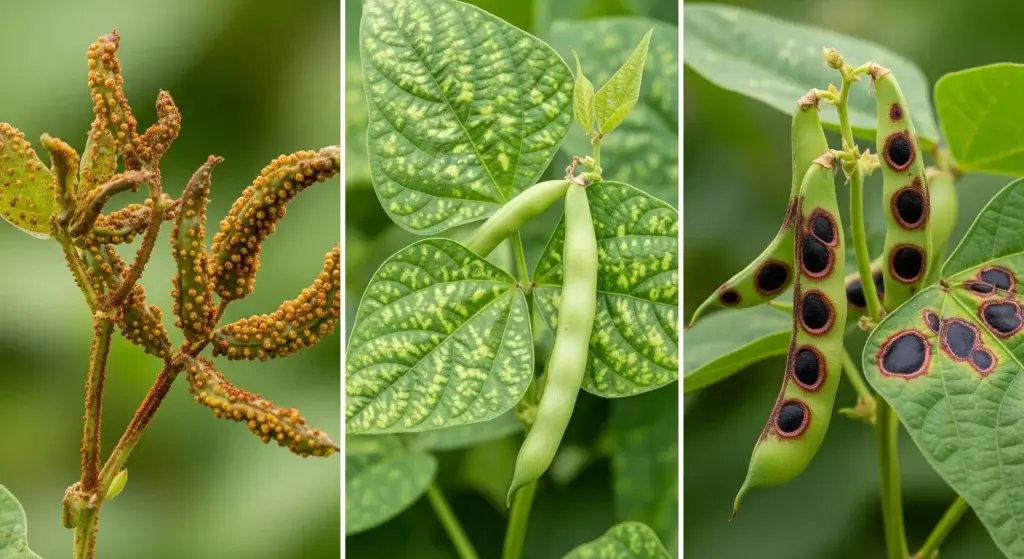
Beets are tasty and tough—but leaf miners? Total leaf vandals.
These sneaky pests tunnel through beet leaves like they own the place, leaving squiggly trails behind.
Catching the signs early is key if you want happy, harvest-ready roots. Think of it as beet defense mode: activated.
Primary Signs of Leaf Miners in Beetroot
Leaf miners are sneaky little jerks. Their babies (larvae) burrow through beet leaves like they’re doodling on your crops.
Here’s how to tell they’ve moved in:
1. Distinctive tunneling patterns
If you see light-colored, wiggly trails on your beet leaves—congrats, that’s leaf miner graffiti.
They come in three flavors:
- Serpentine – Long, curly paths like a garden snake had a party.
- Linear – Straighter lines that still say, “I live here now.”
- Blotchy – Random, patchy damage that looks like your leaf’s having a bad skin day.
2. Translucent or brown leaf patches
Those tunneled spots can turn pale, papery, or brown—like the leaf’s been ghosted by chlorophyll.
- Hold the leaf up to the light: translucent? That’s them.
- Brown or bronze spots = major damage.
- Dry and crispy = time to act fast.
3. Visible larvae within leaves
Peel back the top layer of a tunnel and—yep—there’s the culprit.
Little pale larvae, about 3–4mm long, squirming like they own the place.
No legs. No head. Just leaf-munching machines in white or yellowish-green.
4. Egg clusters on leaf undersides
Flip a leaf over and check along the veins.
If you spot tiny white eggs in little rows or clusters—those are the next generation gearing up.
Leaf miner moms don’t mess around.
5. Premature leaf drop
If the damage gets bad, the plant starts dropping leaves early like it’s fall already.
You might notice:
- Yellowing, limp leaves
- Weak-looking plants
- Stunted growth even if you’re watering right
Your beets will still try their best—but with fewer working leaves, they’re running low on energy.
- Read also: How to Prevent Beetroot Pests Naturally: A Complete Organic Guide
- Read also: Beetroot Diseases and How to Treat Them: A Complete Guide

Factors That Increase Leaf Miner Risk
Alright, let’s talk about leaf miners — those tiny bugs that turn your beet leaves into squiggly art projects.
They’re basically the garden version of hackers, sneaking in and messing with your plants from the inside. Here’s what makes them feel right at home:
Environmental conditions
- Temperature: These pests speed up their life cycle when it’s warm. Think of it as their version of an energy drink.
- Humidity: They thrive in moist conditions. So if it feels like a sauna out there, it’s party time for them.
- Season: Their peak season. While you’re enjoying BBQs and beach trips, they’re busy making baby leaf miners.
Plant factors
- Young growth: They’re picky eaters. Fresh, tender leaves? That’s their sushi bar.
- Plant stress: If your plants are thirsty or low on nutrients, they’re easier targets. It’s like leaf miners can smell the stress.
- Dense plantings: Planting too close together gives them a shady, protected space to move in — kind of like a bug Airbnb.
Garden management
- Crop rotation: Growing beets in the same spot without rotating crops? That’s like renewing a lease for leaf miners.
- Nearby host plants: Got spinach or chard nearby? Those are leaf miner favorites too. You’re basically offering a buffet.
- Weeds: Some weeds can host leaf miners. So yes, even your weeding game matters.
Distinguishing Leaf Miners from Other Pests
Okay, not every weird thing happening to your beet leaves means leaf miners are at it again.
Before you break out the bug spray, let’s play garden detective and figure out who’s really behind the damage:
Leaf miners vs aphids
- Leaf miners: go stealth mode — they burrow inside the leaf, making wiggly tunnels. The leaf surface stays intact, like they’re ghostwriting chaos underneath.
- Aphids: They hang out on the leaves, suck the juice, and leave the place curling, yellowing, and sticky with honeydew. It’s like a frat party on your plants.
Leaf miners vs fungal diseases
- Leaf miners: Their damage looks random, like little scribbles in the leaf.
- Fungal diseases: They leave round spots with crisp edges, kind of like polka dots. No tunnels, just blotches.
Leaf miners vs nutritional deficiencies
- Leaf miners: Mess with specific parts of the leaf. You’ll see individual trails or patches, not the whole leaf affected.
- Nutritional deficiencies: The whole leaf or even the whole plant looks off — yellowing, paling, or weird coloring all over, not just in one spot.
Impact on Beetroot Plants
Leaf miners won’t straight-up murder your beet plants, but they’re definitely the annoying freeloaders of the garden world.
They dig around, leave a mess, and make everything harder for your plants. Here’s how they cause trouble:
Photosynthetic reduction
Leaf miners tunnel through the leaf and wreck the cells that hold chlorophyll — the green stuff plants use to make energy from sunlight. Less chlorophyll = less food = sad beets. That means:
- Slower plant growth (like, why are my beets still tiny?!)
- Lousy root development
- Smaller, weaker beets when it’s harvest time
Basically, your plant’s trying to run a marathon with half a lung.
Increased susceptibility to other problems
Once the leaves are all torn up, it’s open season for other issues.
Those little wounds become VIP entrances for:
- Bacteria (gross)
- Fungi (ugh, again?)
- More pests (it’s a garden rave now)
It’s like leaving your front door wide open during mosquito season — not a good look.
Aesthetic impact
If you’re growing beet greens for eating or selling (because, let’s be real, sautéed beet tops are underrated), leaf miner damage makes them totally unappealing.
Nobody wants to eat leaves that look like they’ve been attacked by tiny crop circles.

Prevention and Early Detection Strategies
The best way to deal with leaf miners? Don’t let them move in at all.
Catch ’em early, set some garden boundaries, and make your beet patch a place they don’t want to party in.
Here’s how:
Regular monitoring
Give your beets a quick once-over every week. Focus on:
- New leaves — that’s prime real estate for leaf miners.
- Undersides of leaves — where they like to sneak in and lay eggs. Tiny white dots? Bad news.
- Color or texture changes — if leaves start looking off, that could be your first clue.
Treat it like plant skincare — catch the signs early, and you won’t need a full-on treatment later.
Cultural Practices
- Rotate your crops – Don’t plant beets in the same spot every season. It’s like changing the locks on leaf miners.
- Space your plants out – Crowding = humidity = happy bugs. Give them room to breathe.
- Pull those weeds – Some weeds are secret leaf miner hosts. If they’re hanging out near your beets, you’re feeding the enemy.
- Feed the soil – Healthy plants fight back better. Good soil = strong beets = fewer problems.
Physical barriers
- Row covers: Basically insect-proof blankets for your plants. Throw these on during peak egg-laying time (spring and summer).
- Yellow sticky traps: Leaf miners are drawn to yellow like bugs to a porch light. Hang a few near your beets and trap the adults before they lay eggs.
When to Take Action
Not every squiggle on your beet leaves means it’s time to go full pest-control mode.
Sometimes you wait, sometimes you act — and sometimes you just accept that nature’s gonna nature. Here’s how to know when to jump in:
Threshold levels
- Light infestation: If you’re seeing 1–2 tunnels per leaf and your plant still looks chill? No need to panic. Monitor and relax.
- Moderate infestation: 3–5 mines per leaf, and now the leaves are yellowing? Time to take action.
- Heavy infestation: Leaves look like a maze, and the plant’s clearly struggling? Yeah… it’s go-time.
Timing considerations
- Early season: Focus on prevention — row covers, sticky traps, and keeping things clean.
- Mid-season: If pest numbers climb past your comfort zone, bring out the organic backup.
- Late season: If your beets are almost ready? Skip the treatment. Let them finish out their glory days in peace.
Organic Management Options
If you’re trying to stay crunchy and chemical-free, there’s good news — plenty of natural tools exist to fight back without nuking your soil.
Natural predators
Encourage beneficial insects that prey on leaf miners:
- Parasitic wasps: Tiny, non-scary heroes that lay eggs inside leaf miner larvae. Brutal but effective.
- Predatory mites: These guys snack on leaf miner eggs and baby larvae. Think of them as pest babysitters with attitude.
- Birds: Set up feeders and birdbaths. The more feathered friends, the better — birds love adult leaf miners for breakfast.
Organic sprays
- Neem oil: Messes with their hormones and stops them from eating and growing. Basically bug birth control.
- Insecticidal soap: Melts soft-bodied pests on contact. Super safe when used right.
- Spinosad: A powerful, organic option that targets larvae. Just don’t go overboard — save it for real battles.
Cultural controls
- Companion planting: Drop in some marigolds, nasturtiums, or herbs like basil and mint. They smell weird to pests — in a good way.
- Trap crops: Sacrifice a few leafy favorites (like chard) nearby to lure leaf miners away from your beets.
- Handpicking: If a leaf looks like it’s been scribbled on? Yank it and toss it far away. Don’t compost it — you’ll just breed more miners.
Chemical Control Options
Alright, if you’ve tried all the organic tricks and your beet leaves still look like they’ve been vandalized by insect graffiti artists, it might be time for chemical control.
Not ideal, but sometimes necessary — especially during a full-blown leaf miner invasion.
Systemic insecticides
These are absorbed by the plant, so when larvae munch on the leaves, it’s game over.
- Imidacloprid: The heavy-hitter. Gets into the plant’s system and knocks out larvae from the inside.
- Spinosad: Technically organic, but strong. Works on larvae, and easier on the environment — kind of like the plant version of a targeted smart bomb.
Contact insecticides
These hit pests on contact — no deep absorption, just wham-bam.
- Pyrethrin-based sprays: Good for adult leaf miners. Use when they’re flying around, looking for a place to lay eggs.
- Malathion: Old-school and broad-spectrum. Use this one only if things are really out of hand.
Application timing
You can’t just spray and pray — you’ve gotta time it right:
- Hit adults early when they’re most active (usually mornings, spring into early summer).
- Protect new leaves — that’s where the larvae love to start their mess.
- Read the label — this isn’t cooking oil. Stick to the recommended dosage and wait times.

Long-Term Management Strategy
Leaf miners aren’t a one-season problem. If you want them out for good, think like a garden strategist.
Integrated Pest Management (IPM)
A fancy name for “do a bit of everything, but smartly.”
- Prevention: Good spacing, crop rotation, weed control — the basics matter.
- Monitoring: Check weekly. Don’t wait until it’s a full horror movie.
- Biological control: Let wasps, birds, and mites do their thing.
- Targeted spraying: Only bust out the chemicals when you’ve hit your threshold. No overkill.
Record keeping
Track what works — and what doesn’t.
- When did the infestation start?
- What was the weather like?
- What did you use, and did it help?
- How did the harvest turn out?
That way, future-you will thank past-you for not winging it next season.
- Read also: How to Control Aphids on Beetroot Plants: A Complete Guide
- Read also: Spinach Leaf Miners: Understanding the Damage and Prevention
Conclusion
Leaf miners love messing with beet leaves, but once you spot those squiggly tunnels and know what to look for, you’ve already got the upper hand.
Catch ’em early, know their habits, and take action before they throw a full garden party.
Whether you’re going organic or bringing out the big guns, the key is staying on top of things — check your plants often, keep your garden clean, and don’t let stressed-out beets become easy targets.
Think of leaf miner control like good skincare: spot the problem early, treat it right, and don’t skip the routine.
Do that, and your beets will stay happy, healthy, and harvest-ready.



